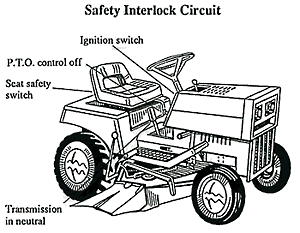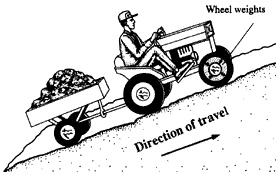Follow
these safety tips and maintenance procedures for checking,
servicing and operating compact tractors to extend their life
and reduce breakdowns and accidents.
Lawn
and turf maintenance is easier because of modern compact tractors,
but carelessness can spell trouble.
Most
tractors used in grounds care can be classified into three
size groups: 1) riding lawn mowers (3 to 8 horsepower) which
are fitted with a mower and usually do not have other equipment
or attachments that could be mounted separately; 2) lawn and
garden or compact tractors (7 to 40 horsepower) that can be
mounted with a variety of tools and equipment; and 3) large
tractors which range from 40 to 80 horsepower and have a low
center of gravity for working slopes. These large tractors
can be equipped with a variety of attachments.
Regardless
of size, you should observe several safety precautions before,
during and after tractor operation. All power units are potentially
hazardous if improperly maintained or operated.
Figure
1. Equipment is noisy; use hand signals to communicate between
operator and other personnel.
The most
important safety function for an operator is to frequently
read the operator's manual. It contains safety tips and procedures
for checking and servicing the equipment. Following these
instructions increases operating life, reduces major breakdowns,
and prevents serious accidents.
Grounds
care equipment is noisy. It is best to communicate with an
equipment operator using the hand signals shown in Figure
1. These hand signals could prevent a serious accident
if a quick reaction is needed.
Take
responsibility for small children in the area and teach them
to respect mowing and moving vehicles. Keep children from
the mowing area and do not allow passengers on the tractor
or dump carts. Explain the harm of sharp blades rotating at
high speeds and the potential for thrown objects which may
move at speeds of 170 mph. For the safety of others, especially
children, never leave a running machine unattended, and always
remove the keys.
Figure
2. Safety clothing and equipment provide extra protection
in the event of an accident.
- Wear
close-fitting, sturdy clothing (Figure 2). Avoid
clothing with tears, bulging pockets, frayed edges and heavy
cuffs that may tangle in revolving equipment parts. Cut-off
trousers or shorts offer no protection from flying debris.
- Wear
heavy, non-slip shoes, preferably with steel toes. Sure
footing is essential to your safety, heels help prevent
slipping and good soles reduce dangers of tripping and falling.
- Wear
earmuffs in excessively noisy conditions (=85 db) to
prevent hearing damage and reduce operator tension and fatigue.
- Wear
a respirator in extremely dusty conditions to protect against
dust, spray and debris that may be blown about.
- Wear
safety glasses or goggles for protection from thrown rocks,
pieces of wire, glass or other objects, and from exposure
to dust and insects.
- Keep
alert. Fatigue, worry, preoccupation, illness and the like
are enemies of safety. Drugs and/or alcohol impair an operator's
skill and judgment. When you begin feeling tired, too hot
or too cold, take a 10-minute break to stretch, walk about,
lie down, or snack. A break restores alertness and helps
you continue the job accident free.
Before
starting the equipment, make these final inspections and adjustments:
- Check
the fuel level and refuel while the engine is cool and in
a well-ventilated area. Wipe off any spilled fuel. Keep
sparks and flames away from the fuel tank and engine. Do
not smoke while refueling. Store additional fuel in a well-marked,
safety storage container. Gasoline storage containers should
be colored bright red. Diesel fuel containers should be
green. Never use plastic jugs or glass jars for a fuel container.
- Check
coolant when the engine is cool on liquid-cooled engines.
Do not remove a radiator cap when the engine is hot, and
never add cold water or coolant to a hot engine.
- Do
not smoke or light a match when checking battery electrolyte
level. Hydrogen gas from a battery, even in low concentrations,
may explode in the presence of a spark or open flame. Keep
the positive battery post covered with a rubber cover to
guard against sparks.
- Adjust
the tractor seat to fit the operator's needs and comfort.
Operator fatigue may contribute to accidents, and a properly
adjusted seat helps prevent fatigue. Improper seat adjustment
may hinder operation of hand levers and foot pedals in an
emergency.
- Adjust
the tread width, tire pressure, tractor weights and cutting
height so the equipment is properly prepared for operation.
Consult
the operator's manual for the correct starting procedures.
Remember the following general tips:
- On
typical systems (Figure 3), before the engine will
start, these items must be satisfied: (a) the ignition key
must be "ON," (b) the transmission must be in neutral, the
clutch pedal depressed, or both, (c) PTO or mower must be
disengaged, and (d) the operator must be properly seated.
- Do
not operate an electric starter for more than 30 seconds
at a time because of heat build-up in the starter motor.
If the engine will not start, turn the key to "OFF" and
wait for a minute or two before trying again.
- Provide
good ventilation if you must start an engine indoors. Such
engines give off carbon monoxide, a poisonous, odorless
and colorless gas.

Figure
3. Many compact tractors have an interlock safety system.
Do not remove these devices; they are for your protection.
- After
the engine has started, make a final check to be sure all
persons, pets and obstructions are out of the area.
- Move
the gear shift lever to the desired gear and engage the
clutch slowly, following the manufacturer's recommendations
for shifting. On most tractors, start out in the gear you
intend to use for driving or operating.
- Smooth
starts are essential both for equipment and operator safety.
Apply power gradually to the drive wheels. Do not "pop"
the clutch by letting it out too fast. Engaging the clutch
too quickly can result in overturning the tractor backward.
Bring the tractor to a full stop before changing gears.
- Before
starting to mow, check the area and remove any debris (rocks,
cans, wire, toys, etc.) that might be thrown if struck by
a rotating mower blade.
- Locate
solid obstacles that might be hidden in the grass or overgrowth
(large rocks, boundary stakes, irrigation heads, stumps,
etc.). Avoid low-hanging branches, electric lines and guy
wires that can cause costly equipment damage, tractor upsets
and operator injuries.
- While
maneuvering the tractor, be alert and watch the area ahead
for moving vehicles, people or animals that might cross
the path of the tractor. Be prepared to change course or
stop.
- Avoid
mowing too close to trees. The equipment may damage a tree,
and low branches may distract you and lead to an accident.
Wood chips placed at the tree's base will keep the turf
neat and trimmed and will keep the mower away from the tree
base.
- Reduce
speed while operating on embankments; a hole, bump, or quick
turn may result in tragedy. Use the widest possible wheel
spacing and keep the tractor properly ballasted (Figure
4). Mow up and down the slope with a lawn tractor. If
you must climb a steep slope, go up in reverse to reduce
chance of a backward overturn.

Figure
4. Downshift to a lower speed when climbing steep grades.
Loads on the rear increase the chance of backward upset.
Add front wheel weight for balance.
- Stay
clear of ditches, embankments and ponds. Apply power carefully
when driving out of a ditch; a tractor upset happens easily
under these circumstances. A roll bar and seat belt will
protect the operator, but cautious operation should be the
first priority.
- Leave
the tractor in gear when going downhill. The engine acts
as a brake.
- While
backing, look behind to be sure the way is clear. Some lawn
and garden tractors have a forward/reverse lever that reverses
the tractor with a short pause. Be sure to bring the tractor
to a full stop; look and be alert as you reverse directions.
- Stop
mower blades before crossing gravel patches.
- Do
not drive lawn and garden tractors on streets or highways.
Their small size can make them difficult to see.
- Never
dismount from the operator's seat while attachments are
running.
- If
a mower becomes clogged, be sure the rotary blades are turned
off and completely stopped. Never put your hands under
a mower deck if there is any possibility blades are still
rotating.
Proper
stopping procedures can influence the ease with which the
equipment starts the next time. An operation is not successful
until the operator has safely dismounted and the equipment
is properly put away. Remember to:
- Remove
the load from the engine to lessen shock on the bearings
and reduce wear.
- Place
the transmission in park or neutral. Set the brakes, and
lower any mounted implements to the ground. Serious injury
may result if raised equipment accidentally drops.
- Reduce
engine speed, and allow engine to cool one or two minutes
at one-third throttle speed and no load. This allows hot
spots to cool and prevents possible damage to seals and
valves.
- Reduce
engine speed. Turn the switch to "OFF." Leaving the ignition
switch "ON" causes the battery to discharge. Do not dismount
from the operator's platform until the engine and all implements
are no longer in motion.
- Dismount
carefully; falls are a leading cause of accidents.
- Close
the fuel tank shut-off valve to take the pressure off the
carburetor diaphragms and/or float. A closed valve prevents
fuel leaks and potential fires.
- If
the engine has an ignition lock and key, remove the key
before leaving the engine as a safeguard against unauthorized
operation. If the engine has no ignition key, remove the
spark plug wire from the plug.
These
safety tips and maintenance procedures for checking, servicing
and operating compact tractors extend equipment life and reduce
breakdowns and accidents.
- Colvin,
T.S. 1974.
Grounds
Keeping Equipment Vol. 1; Operating
Tractors
for Ground Keeping and Ornamental horticulture. AAVIM.
Athens, GA pg 95.
Publication #: G89-948-A
Robert
Grisso, Extension Agricultural Engineer
Rollin Schnieder, Extension Safety Specialist
File
G948
under: HEALTH AND SAFETY
A-10, Accident Prevention
Issued December 1989; 12,000 printed.
Electronic version issued August 1996
Issued in furtherance of Cooperative Extension work, Acts
of May 8 and June 30, 1914, in cooperation with the U.S. Department
of Agriculture. Kenneth R. Bolen, Director of Cooperative Extension,
University of Nebraska, Institute of Agriculture and Natural
Resources.
University of Nebraska Cooperative Extension educational programs
abide with the non-discrimination policies of the University
of Nebraska-Lincoln and the United States Department of Agriculture.
Disclaimer and Reproduction Information: Information in
NASD does not represent NIOSH policy. Information included in
NASD appears by permission of the author and/or copyright holder.
More

